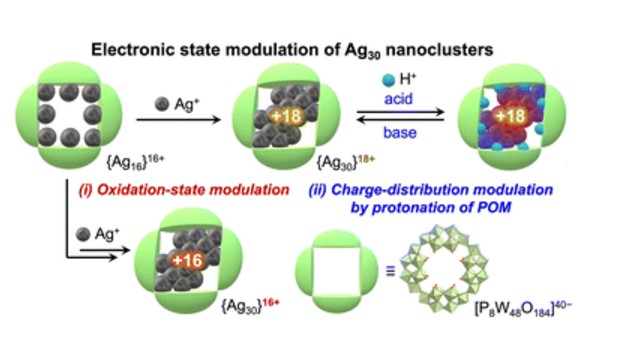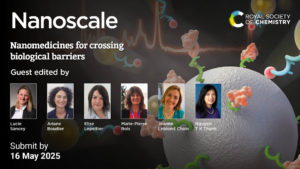Metal Nanoclusters
Guest edited by Sukhendu Mandal, Yuichi Negishi, Di Sun and Anindita Das

Discover the latest research in this Nanoscale collection.

Atomically precise metal nanoclusters are novel materials that have the potential to address everyday needs from energy to health. Luminescent metal clusters can be used for effective and efficient energy harvesting and conversion technologies, while water-soluble luminescent metal clusters offer more efficient and personalized biomedical approaches. Furthermore, nanoclusters can be used as building units to form higher-dimensional cluster-assembled materials and can modulate the optoelectronic properties of desired device materials. To create a hierarchy of structures and applications existing collaboration and foster new ones and explore opportunities for students.
This collection in Nanoscale aims to look at new structures, photophysical, chemical and electrochemical catalysis reactions, and structure-property correlations within the themes of atomically precise metal nanoclusters.
We invite you to discover the latest research from metal nanoclusters collection and to read the introductory editorial written by guest editors Sukhendu Mandal, Yuichi Negishi, Di Sun and Anindita Das
All articles in the collection are free to read until the 30th of January 2025.
Read the introductory editorial
Check out some of the featured articles below:
|
|
Electronic state modulation of Ag30 nanoclusters within a ring-shaped polyoxometalateSufei Zhou, Di Liu, Kelong Fan, Haile Liu, and Xiao-Dong Zhang Nanoscale,2024,16, 18644-18665 |
|
 |
Atomic-level design of biomimetic iron–sulfur clusters for biocatalysisDaiki Yanai, Kentaro Yonesato, Soichi Kikkawa, Seiji Yamazoe, Kazuya Yamaguchi and Kosuke Suzuki. Nanoscale, 2024,16, 18383-18388 |
|
 |
Synergism between copper and silver nanoclusters induces fascinating structural modifications, properties, and applicationsPriyanka Sharma, Mainak Ganguly, and Ankita Doib Nanoscale, 2024,16, 18666-18683
|
|
![the graphical abstract image depicting ditopic ligand effects on solution structure and redox chemistry in discrete [Cu12S6] clusters with labile Cu–S bonds](https://blogs.rsc.org/nr/files/2024/12/Screenshot-2024-12-12-065259.jpg) |
Ditopic ligand effects on solution structure and redox chemistry in discrete [Cu12S6] clusters with labile Cu–S bondsMichael J. Trenerry and Gwendolyn A. Bailey Nanoscale, 2024,16, 16048-16057. |
|
We hope you enjoy reading some of the latest research on metal nanoclusters!
Nanoscale is a high-impact international journal, publishing high-quality research across nanoscience and nanotechnology. Find out more about the journal on our platform and send your submissions now. We look forward to considering your research.































